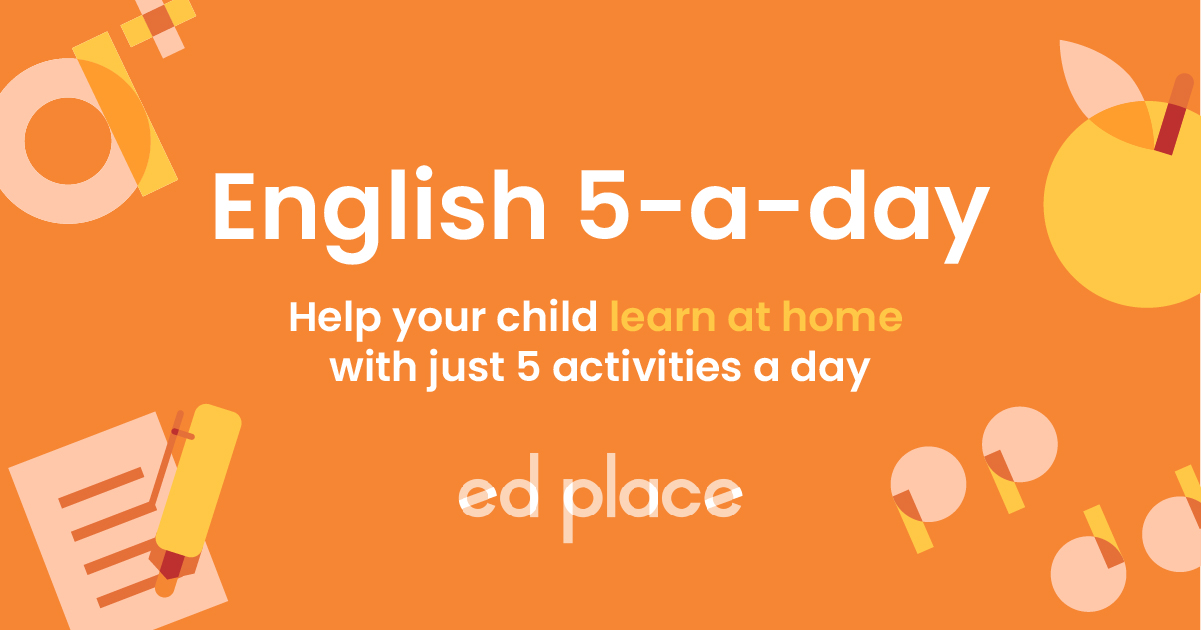
EdPlace's Year 8 Home Learning English Literature Lesson: Understand Context and Character Development
Looking for short lessons to keep your child engaged and learning? Our experienced team of teachers have created English, maths and science lessons for the home, so your child can learn no matter where they are. And, as all activities are self-marked, you really can encourage your child to be an independent learner.
Get them started on the lesson below and then jump into our teacher-created activities to practice what they've learnt. We've recommended five to ensure they feel secure in their knowledge - 5-a-day helps keeps the learning loss at bay (or so we think!).
Are they keen to start practising straight away? Head to the bottom of the page to find the activities.
Now...onto the lesson!
Why Study Nineteenth Century Fiction?
Reading a novel to study is not quite the same as reading for pleasure- although tackling one of ‘the classics’ may leave a sense of satisfaction that lasts a lifetime! A selection of well-known texts, and their authors, form part of what has become known as the ‘literary canon’. This extended knowledge forms the basis of a well-rounded education; even if this simply helps you score extra points at quiz nights in the future!
By the time students reach GCSE, they will need to be ready to take on some Nineteenth Century fiction, so it's often introduced during KS3 through well-known poetry, or extracts from novels. Many memorable characters live within the pages of these texts and exploring them is a great way to begin. Here we will offer a simple process to study and analyse how characters are presented in fiction – whether it’s ‘Harry Potter’ read for pleasure, or a Victorian novel studied for GCSE. Employing these techniques when reading a novel of choice, will then make reading a novel for ‘study’ a little less daunting.
We’re confident that by the end of this guide your child will be able to:
1) Understand how specific texts fit into a historical and cultural context
2) Label different types of characters
3) Identify different ways writers reveal and develop their characters' personalities
Step 1: Identify Different Character Types
When writing about different kinds of characters there are key words students must get to grips with to make their writing more advanced.
1) Character = a fictional creation in a novel, poem or play
2) Protagonist = the main character; a story may be named after them
3) Stereotype = an easily recognisable ‘type’ such as a doctor or priest – they are functional in developing the experiences of the main character
4) Caricature = an exaggerated character, they may seem ‘larger than life’ to add humour or make fun of themselves.
5) Static/one-dimensional characters = these characters don't change, may be only good or bad, but may also be functional and help to move the story along
Being able to accurately label characters is an important first step to analyse their role in a novel, and is an impressive use of literary language too!
Step 2: Putting Nineteenth-Century Literature into Context
In brief, the earliest fiction writer in English is regarded as being Geoffery Chaucer (died 1400 AD), AKA ‘the father of English literature’ who is best known for ‘The Canterbury Tales’. Though they are not generally studied until A-level, due to the differences in the language (and some racy content), that’s all one needs to know at Year 8!
Jumping along a few centuries to William Shakespeare, we may have heard a sonnet read at a wedding, and most of us can name at least a couple of his plays; at least one will be studied at KS3.
Skipping again to the beginning of the 1800s, we need to know the term ‘Romanticism’. In short, writers such as Wordsworth (his daffodils and lonely clouds) and Coleridge (The Rime of the Ancient Mariner) sparked a new interest in the power of Nature, and the importance of imagination, which has continued to influence writers to this day. Poetry remained popular during this period and some key poems are included in our worksheets (listed below).
As printing technology developed, books became more affordable during the reign of Queen Victoria, and a new form of writing - the novel - flourished. It will be a novel from this period that is studied in depth at GCSE. Students get a headstart by building their knowledge of Nineteenth Century literature in Year 8, helping them to develop the skills required for Year 9 English literature and beyond!
Step 3: How to Approach Character Analysis
Studying a novel involves examining its different parts including: the plot and structure, the setting, the language used and reoccurring themes and ideas. In this article, we will begin with ‘how to’ build an understanding of the ways writers create characters.
Following this step by step approach to character analysis will help bridge the gap between age-appropriate reading at KS3, and the Nineteenth-Century novel studied in KS4.
1) First, students must notice how the narrator describes them: descriptions of their features, habits, clothing, even how they move. These all paint a picture in the reader's mind's eye. However always remember that the writer controls how and when this information is revealed, so look out for clues – they can even be found in what the writer leaves out!
2) Be alert to what they do: take note of the character's actions and how the plot develops around them. The protagonist will be the main character and the story will build around the conflicts and adventures they experience.
3) Consider what they say: how they present themselves, and how they think or feel. This will be the words used in the first-person, either as part of a narration, letter, or as direct speech. We can also deduce ideas about them; they may reveal more than they intend…
4) Think about what other characters say about them: what are their relationships like? How do other characters treat them or react to them? Which characters have their own motives that influence what they say? Who do we think has a reliable or fair opinion?
Now, let's look at how the character of Hagrid is introduced in J. K. Rowling's ‘Harry Potter and the Philosopher’s Stone’. Each quote is an example of the points made above.
This description emphasises his size and uniqueness:
"He was almost twice as tall as a normal man and at least five times as wide. He looked simply too big to be allowed, and so wild – long tangles of bushy black hair and beard hid most of his face, he had hands the size of dustbin lids and his feet in their leather boots were like baby dolphins."
His actions demonstrate an affectionate nature in contrast with his physical strength:
"He bent his great, shaggy head over Harry and gave him what must have been a very scratchy, whiskery kiss. Then, suddenly, Hagrid let out a howl like a wounded dog."
His own words match his sentimental actions, making him seem honest:
" ‘S-s-sorry,’ sobbed Hagrid, taking out a large spotted handkerchief and burying his face in it. ‘But I c-c-can’t stand it – Lily an’ James dead – an’ poor little Harry off ter live with Muggles –’ "
This comment endorses him as a dependable character:
" ‘I would trust Hagrid with my life,’ said Dumbledore."
Step 4: Attempt Character Analysis Yourself...
Below are some quotes about the main characters from different GCSE novels. Identify one of the four techniques discussed in Step 3, that you would transfer to analyse each Nineteenth-Century extract. Which one of the four approaches would you apply to each quote?
A) ‘Oh! But he was a tight-fisted hand at the grind-stone, Scrooge! a squeezing, wrenching, grasping, scraping, clutching, covetous, old sinner!’
B) “I am no bird; and no net ensnares me; I am a free human being with an independent will.”
C) “There is something wrong with his appearance; something displeasing, something downright detestable. I never saw a man I so disliked, and yet I scarce know why.”
D) ‘Sherlock Holmes took his bottle from the corner of the mantel-piece and his hypodermic syringe from its neat morocco case.’
E) "She is tolerable, but not handsome enough to tempt me; I am in no humour at present to give consequence to young ladies who are slighted by other men."
Finally, we need to explore how they change or develop during the course of the novel. Students should ask themselves how is a particular character presented at the beginning? What happens to make them change? What are they like at the end of the novel? Does the story begin with them in childhood and relate the events that mould them into adults? Tracking these changes gives plenty to analyse and comment on. Getting to know the characters is both a fun and accessible way into challenging texts. Treating character analysis as a hunt for clues helps to make it rewarding while developing reading ability.
Step 5: Activities
The following worksheets look at a variey of classic poems and novels from the Nineteenth Century which will build knowledge of key texts, further ensuring your child has a headstart at the topic.
All activities are created by teachers and automatically marked. Plus, with an EdPlace subscription, we can automatically progress your child at a level that's right for them. Sending you progress reports along the way so you can track and measure progress, together - brilliant!
Activity 1 - Reading Fiction for Historical Context: Frankenstein
Activity 2 - Compare Two Monsters in Fiction: Frankenstein and Dracula
Activity 3 - Ballads: 'The Lady of Shalott' by Alfred Lord Tennyson
Activity 4 - Compare Poems on a Theme: 'To Autumn' and 'Ode to Autumn'
Activity 5 - Reading Poetry: 'The Charge of the Light Brigade'
Why not try the extension activity if you really want to push yourself?
Extension - Analyse Fiction: 'Hard Times' (Chapter 5)
Answers:
A = How does the narrator describes the character? – introduction of Scrooge (A Christmas Carol by Charles Dickens)
B = What does the character say? - direct speech (Jane Eyre by Charlotte Brontë)
C = What do others say about the character? – a character speaking about a character (Dr Jekyll and Mr Hyde by Robert Louis Stevenson)
D = What are the character's actions? – what can we deduce from this about Sherlock Holmes and his habits? (The Sign of Four by Arthur Conan Doyle)
E = What do others say about the character? (Darcy speaks about Elizabeth) What do they say about themselves without meaning to? – Darcy reveals his own attitude too! (Pride and Prejudice by Jane Austin)








